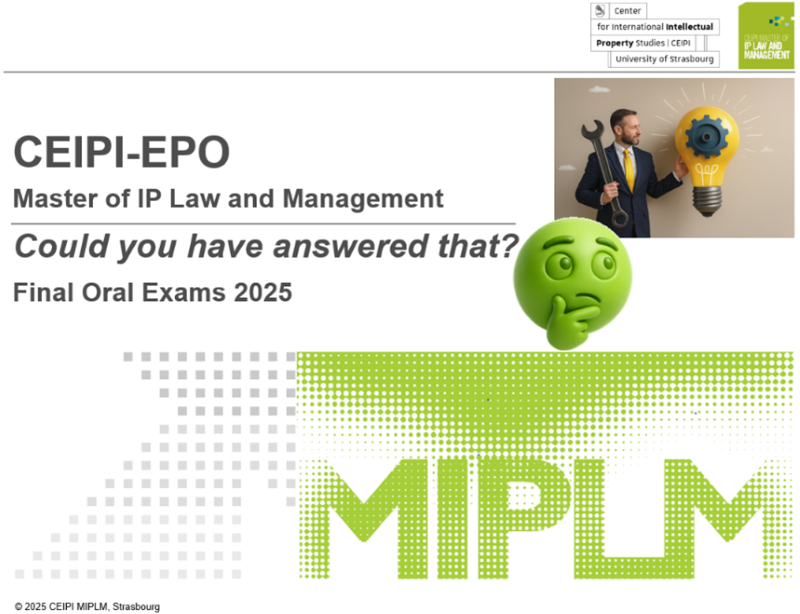Could you have answered that? Cracking the CEIPI EPO MIPLM’25 Exam on IP Integration in Product Development Process
In Question 25 of the final oral examinations for the CEIPI-EPO Master in IP Law and Management, students are asked to describe the role of IP in the product development process.
The exam question
This year’s exam case confronts MIPLM candidates with the practical realities of aligning innovation and intellectual property during product development. The fictional company NeuroTrack GmbH is a German medtech startup developing a smart neurostimulation device that combines hardware, software, and connectivity features. As they prepare to move from a prototype to a marketable product, the company wants to understand how IP can be strategically integrated into each stage of their development process. The challenge for the candidate is to design a comprehensive IP integration approach that supports innovation, protects assets, manages risks, and strengthens the company’s position in a competitive market. The response must demonstrate a solid grasp of the stages of product development and the IP tools, decisions, and actions relevant at each phase.
Here you find the 🔎IP Management Glossary entry on Innovation Process
Here you find the 🔎IP Management Glossary entry on Innovation
What can be learned from the lecture
The Module 3 lecture on “Innovation and IP” provides a systematic framework for answering this question. It describes innovation as a structured and phase-based process, moving from idea generation to concept development, prototype creation, and ultimately market introduction. Each phase requires different IP considerations, and ignoring these interdependencies can result in missed protection opportunities, legal vulnerabilities, or competitive disadvantages.
One of the core takeaways from the lecture is the necessity to synchronize product and IP development. In the early phases, innovation is open-ended and exploratory. This requires mechanisms to capture and document ideas, conduct novelty searches, and avoid infringement. In later phases, as concepts solidify, strategic decisions must be made about whether and how to protect individual components through patents, design rights, or trade secrets.
The module introduces a variety of practical tools such as invention disclosure forms, idea evaluation matrices, IP landscape analysis, and freedom-to-operate (FTO) studies. These tools serve both as decision support and documentation, helping innovators and IP teams work in parallel.
The lecture also emphasizes the need to consider IP not just for protection but as a driver of innovation, enabling exclusive positions in the market, licensing opportunities, and stronger investor communication. For this to succeed, IP responsibilities must be clearly embedded in the development process with cross-functional coordination.
IP Business Academy experts contributing to this topic
Several Subject Matter Experts featured on the IP Business Academy platform have shared actionable insights related to the exam topic:
- Nicos Raftis, Inventing around with clarity of function and structure
- Alihan Kaya, Green Technologies and Patents
- Daniel Holzner, AI-assisted invention process
- Robert Klinski, Invention Harvesting
- Sascha Kamhuber, Patentinformation in the Steel Industry
- Max Feucker, IP Process Management
- Olier Baldus: Lean IP | Agile Strategy for Business Value
Learners can find deep dives, articles, and even webinars on:
📑 IP Management Letter: Navigating the Complexities of Product Development and IP Management
📑 IP Management Letter: Lean IP is Revolutionizing IP Management in Today’s Industries
📑 IP Management Letter: Navigating Patent White Spots for Business Success
🎧 IP Management Voice Episode #42: Innovation Through Meaning – Design and AI
🎧 IP Management Voice Episode #42: The Power of Stage-Gate Systems
Sample solution
A strong response to the exam case begins with mapping the product development process into distinct stages and assigning corresponding IP activities and decisions to each.
- During the idea generation phase, the focus is on capturing and reviewing the technical and commercial potential of various ideas. NeuroTrack GmbH should introduce an invention disclosure form that employees and founders use to document technical contributions. This form becomes the basis for internal reviews, novelty checks, and early protectability analysis. A centralized IP register ensures that ideas are tracked, and similar ideas are grouped to assess synergy or redundancy.
- In parallel, a high-level freedom-to-operate check is performed. This involves using publicly available patent databases to identify potential third-party rights that could block certain technical approaches. Although this search is not exhaustive, it informs early pivot decisions in technology development and reduces wasted effort.
- In the concept development stage, selected ideas mature into system concepts. At this point, it becomes necessary to evaluate protectability in more detail. NeuroTrack should assess which components of the neurostimulation system offer novelty, inventive step, and industrial applicability. This includes examining the electrode design, the configuration of AI algorithms, and the control app interface. The company also identifies parts of the system that should remain as trade secrets, such as calibration routines or parameter tuning methods.
- At this stage, a provisional patent application may be considered for key inventions. Provisional filings help secure a priority date while allowing time to develop the invention further. Parallel to this, the product architecture is reviewed from an IP perspective. Key product features are mapped to the corresponding IP assets—be it patents, designs, trade secrets, or trademarks. This mapping helps ensure that each element of the product has a corresponding IP strategy.
- As the project moves into the prototype development phase, the emphasis shifts to detailed technical implementation and testing. Now, the FTO analysis becomes critical. The startup must engage IP professionals to conduct a structured FTO study, especially for software modules, wireless interfaces, and therapeutic protocols that may be covered by existing patents. If risks are identified, the company can explore licensing, technical workaround, or design-around options.
- Meanwhile, patent applications are prepared and filed in relevant jurisdictions. At the same time, NeuroTrack considers design filings for the physical shape of the wearable device and the user interface screens. These are especially important because users often interact directly with these elements, and their visual identity can contribute significantly to brand value.
- The company should also evaluate the need for trademark protection. If the product or the app has a distinctive name, it should be cleared and filed in the relevant classes and regions to prevent brand imitation or confusion.
- Entering the market introduction phase, the IP strategy must now support commercialization. The filing strategy must ensure that core patents are published at the right time to prevent competitor filings while supporting PR and investor visibility. Trademarks must be registered and ready for launch. Design rights must cover the final version of the device. Any open-source software components must be reviewed for license compatibility.
- The startup must also finalize its internal and external agreements to ensure clarity of IP ownership. Employees, freelancers, and external developers must have IP clauses in place, ensuring that all work results are assigned to the company. Collaboration agreements must define who owns jointly developed IP and who can use what under which conditions.
- Throughout all these phases, IP strategy workshops can be held with cross-functional teams to discuss progress and realign priorities. These workshops also serve as training sessions, reinforcing IP awareness and compliance across the company.
- One of the key success factors in this approach is the synchronization between the product lifecycle and the IP lifecycl Filing too early can limit scope; filing too late can jeopardize novelty. Public disclosures during clinical trials or demo presentations must be timed carefully to avoid unintended prior art. Grace periods should be considered in countries like the US, but not relied on in jurisdictions where they do not exist.
The benefits of this structured approach to IP integration are significant. NeuroTrack can secure exclusivity on critical components, manage risks in third-party environments, and present a stronger case to investors or partners. The company can also reduce product launch delays caused by last-minute legal challenges. Most importantly, by embedding IP into the innovation process, the startup ensures that creativity is matched with control and scalability.
Conclusion
This exam question reflects a central challenge for all innovation-driven businesses: how to align product development with a proactive and structured IP strategy. The lecture from Module 3 provides the essential process logic, tools, and decision frameworks to make this alignment possible. Candidates who understand that IP is not an add-on but a value driver throughout the innovation process will be well prepared to answer.
The contributions from experts like Nicos Raftis, Alihan Kaya, Daniel Holzner, Robert Klinski, and Sascha Kamhuber show how this theoretical knowledge plays out in practice. They provide examples of how to manage interface design protection, IP clearance in agile projects, software component risks, and much more.
For MIPLM students and IP professionals, this case is a reminder that successful innovation depends not only on good ideas and technical solutions but also on intelligent protection. The integration of IP into the product development process is both an operational necessity and a strategic advantage. Knowing how to execute this integration is what turns innovation into impact.
And that’s the kind of thinking that could help you pass the MIPLM oral exam—and more importantly, shape the future of IP management.



